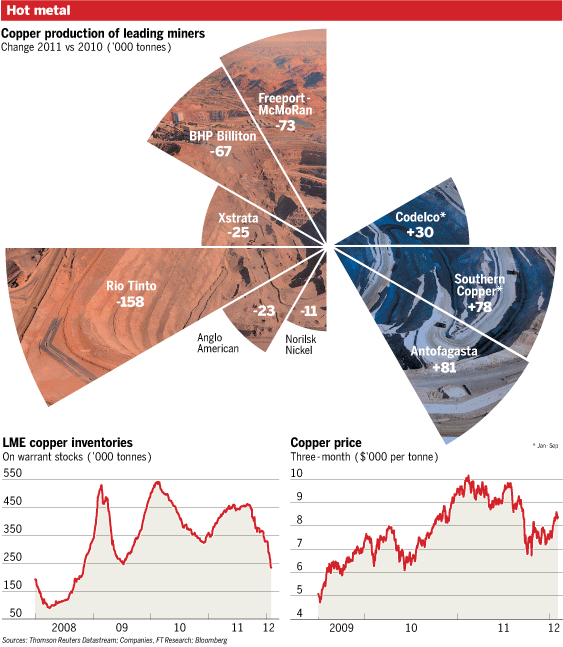Copper bulls eye $10,000 on China demand

The bulls are back. Industrial metals such as copper bore the brunt of last year’s financial turmoil, shaking belief in a “supercycle” of rising prices. Now, though, they are enjoying a renewed wave of investor interest.
As a group, metals recorded their best monthly performance in January since December 2010, with the basket of London Metal Exchange futures rising 10.9 per cent, led by a 26.5 per cent surge in the price of tin.
The rally in prices has reawakened talk of copper reaching $10,000 a tonne, a level briefly exceeded amid last February’s optimism but which looked increasingly unlikely as prices tumbled to a low of $6,635 a tonne in October. Since the start of this year, the red metal has risen 11 per cent to trade on Wednesday at $8,440.
The rise in copper, a bellwether for global industrial production thanks to its widespread uses in construction and manufacturing, underscores a shift in perceptions about the global macroeconomic outlook in recent weeks. The rally in metals has also lifted sentiment towards the mining industry, with the FTSE European mining index rising 17.4 per cent since the start of the year.
Ric Deverell, head of commodities research at Credit Suisse, says the mood among investors has seen “a dramatic change from six weeks ago where everyone was so bearish”.
“The underlying [demand] was nowhere nearly as bad as sentiment in the fourth quarter,” he says.
Traders have become more relaxed about the two dominant fears stalking markets at the end of 2011. First, the full force of the eurozone debt crisis on the global economy appears, for now at least, to have been deferred by emergency action from the European Central Bank.
Second, and more importantly for metals, commodity traders have become more optimistic about demand in China following record copper imports in December and signs of looser monetary policy.
“I do not share the pessimism about the Chinese economy,” says a senior executive at a commodities trading company. “Credit is easing and that correlates at a later stage with stronger growth.”
An executive at a leading copper miner notes that Chinese buyers stepped up their purchases of the metal on annual supply contracts for 2012 – “and they wanted even more”, he adds.
Copper bulls are not merely surfing a wave of general market optimism, however. The start of the year has refocused attention on a long-running trend of supply tightness for the metal.
Most of the world’s largest copper miners have reported falls in production for 2011, despite a record high average price over the year. The collective output of the large London-listed miners, BHP Billiton, Xstrata, Anglo American and Rio Tinto, fell 8.2 per cent, or 273,000 tonnes, compared with 2010. Glencore has not yet reported full-year production data.
“Over the last few months, investors have been preoccupied with the demand-side risks,” says Duncan Hobbs, metals analyst at Macquarie. “Now they might return to focus on the supply side of the story, which has been relatively neglected.”
The disappointing production data have been accompanied by a sharp drawdown in inventories at LME-registered warehouses. Since early October, copper stocks have fallen 30 per cent. Excluding metal that is waiting to be delivered out, LME inventories stand at the lowest level since October 2008. “Stocks do have some impact at a certain point, particularly the visible stocks. If they creep below critical levels, it can be explosive,” says Simon Collins, head of refined metals at Trafigura, the second-largest metals trader. “$10,000 for copper is a possibility.”
For all that, however, caution pervades. After last year’s harrowing experience, when an air of unbridled optimism about the copper market rapidly dissolved as Chinese traders cut imports, investors are nervous.
The number of contracts outstanding on the LME, or open interest, remains well below recent peaks, suggesting low levels of confidence among traders and investors. And while overall investor positioning in the US copper futures market recently turned bullish for the first time in two months, according to the Commodity Futures Trading Commission, it remains unenthusiastic by the standards of early 2011.
“People have become very humble about this – and rightly so,” says a portfolio manager at a leading commodities hedge fund.
That leaves many funds hoping for a fall in prices in order to buy.
And, in another echo of early 2011, some fear that China’s copper consumers, renowned for their sensitivity to prices, may step back from the market. “If the price is at $8,500, I don’t think they need more straight away,” says Mr Collins of Trafigura. “If it starts to sink to $7,500 I think they’ll buy more.”
Once again, therefore, copper investors find themselves trying to second-guess Chinese buyers. As Michael Jansen of JPMorgan puts it: “There’s a lot of déjà vu here.”
By Jack Farchy in London
Comments
Post a Comment